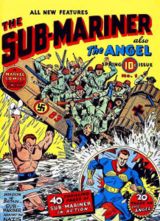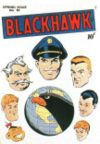Pages 735-760
This page-by-page annotation is organized by sections, as delineated by the seven squares (sprockets) which separate each section. The page numbers for this page-by-page annotation are for the original Viking edition (760 pages). Editions by other publishers vary in pagination — the newer Penguin editions are 776 pages; the Bantam edition is 886 pages.
Contributors: Please use a 760-page edition (either the original Viking edition with the orange cover or the Penguin USA edition with the blue cover and rocket diagram — there are plenty on Ebay for around $10) or search the Google edition for the correct page number. Readers: To calculate the Bantam edition use this formula: Bantam page # x 1.165. Before p.50 it's about a page earlier; as you get later in the book, add a page.
Finally, profound thanks to Prof. Don Larsson for providing the foundation for this page-by-page annotation.
Page 738
738.19 Mickey Wuxtry-WuxtryThe last name is the archetypal newsboy’s cry: "Wuxtry! Wuxtry! [Extra! Extra!] Read all about it!" The spelling was commonly used in the 1940s: Jack Kirby’s Boy Commandos, or The Newsboy Legion; a painting by Albert Abramovitz (at the Harn Museum of Art); and articles in Time and Newsweek, among others.
Page 742
742.29 The Fool
In the March 21, 1969 Time cover story on astrology and the occult (see note at 31.28), the following reference to this otherwise-obscure group occurs: "A California rock group called The Fool has recorded several zodiacal songs — not only because they believe only in astrology, but because they feel generally tuned in to the entire occult world (the Fool is the card in the fortunetelling Tarot deck that stands for Man)" [sic] (48).
Page 750
750.11-13 on his camera dolly, whooping with joy, barrel-assing down the long corridors at NymphenburgThe palace, near Munich, was the birthplace of King Ludwig II of Bavaria and also provided some of the sets for Alain Resnais’ Last Year at Marienbad (along with Ludwig's own Herrenchiemsee), one of several anachronistic references to postwar modernist films in the book, especially here towards the end. As viewers know, Resnais' film features long tracking shots down the corridors of these sets. (See also the reference to the "Bengt Ekarot / Maria Casares Film Festival" at 755.3-4. As Weisenburger notes, both actors played the role of Death, in Bergman’s The Seventh Seal and Cocteau’s Orpheus, respectively.) See note at 394.22.
Page 752
752.01-03 Philip Marlow [sic] . . . Bradbury Building
Philip Marlowe did have his office in in the Bradbury Building in one film adaptation of Chandler’s works: Marlowe (1969), based on The Little Sister, starring James Garner. The Bradbury, long neglected and probably best known as a major setting in Ridley Scott’s Blade Runner (1982), has been restored and recognized as one of the most remarkable pieces of architecture in Los Angeles.
Some corrections to Weisenburger’s notes: Timely Comics, Atlas Comics, and Marvel Comics were all variant titles for the same company, known only by the last name since the 1950s. Sub-Mariner (pronounced "Sub-MARE-iner") was first created by Bill Everett for a one-time black-and-white giveaway comic called Motion Pictures Funnies Weekly. The character made his first full appearance in issue #1 of Marvel Comics (published under the Timely Comics label). Prince Namor (not "Namore") was and remains an unusual hero, since he often has battled mankind and human/humanoid superheroes. As Prince of Atlantis, he was at first pledged to the destruction of humanity. By the time America entered World War II, he had become part of various teams working to defeat the Axis powers. He rarely, if ever, wore a cape. Pynchon’s use of the character here is puzzling for several reasons. First, the super-powered Atlantean had no need for a battery-powered vehicle since he could breathe and swim underwater at high speeds (see picture on linked cover). Second, despite his team-ups with other groups during the war, he does not seem ever to have been part of a "multi-lingual crew." It may be that Pynchon never actually read the comic book. (His other superhero references — including Superman, Batman, and Wonder Woman — are mostly to heroes from Marvel’s publishing arch-rival, the DC publishing group.) Pynchon may, like many of the comics’ readers, have pronounced the hero’s name "Subma-REEN-er" and assumed that he actually commanded an underwater vehicle. He may have confused this character further with Blackhawk, the flying ace who did command a "multi-lingual crew" (including American, English, Dutch, Swedish, Free French, Polish, and a horrible, racist portrayal of a Chinese cook)!
752.07 The Lone Ranger will storm in . . .
The Lone Ranger began as a locally-produced program on Detroit radio station WXYZ (which also produced Sergeant Preston of the Yukon and The Green Hornet). It began its television life (with Clayton Moore in the title role) in 1949 on the ABC network. The real name of the Ranger was John Reid. Dan (Jr.) was his nephew, son of John's murdered brother. Dan was featured in a number of radio and TV episodes (and would eventually be the father of Britt Reid, the secret identity of the urban vigilante The Green Hornet!). Here, the Ranger and Tonto are too late to save the nephew.
752.10 Tonto, God willing, will put on his ghost shirt ...
A reference to the Ghost Dance movement among Native Americans in the 1870s. A Paiute known as Wovoka became a messianic figure as he preached that a dance would eventually restore American Indians to their rightful place in the world and cause the whites to disappear. Part of the movement involved the weaving and wearing of "ghost shirts," which it was believed would give the wearer immunity from soldiers’ bullets. White fear of these beliefs ultimately contributed to the massacre at Wounded Knee in 1890 and the end of both the Ghost Dance movement and Native American resistance to white "manifest destiny." The reference to "cold fire" and the role of the shirt in relation to this passage remain unclear. Also see reference at p. 697.
Presumably Tonto resharpens his knife to renew the Amerindian revenge against the white man, a fire which has gone cold. More failure for the Lone Ranger. God is mentioned six times on pages 751-753.
752.14 Yes, Jimmy
Superman is speaking to his good pal, Daily Planet cub reporter Jimmy Olsen.
752.14 here, where everybody else walks around suntanned, and red-eyed from one irritant or another
In a shift to the present, "here" is sunny, polluted Los Angeles.
Page 755
755.06 an inverted "peace sign"
Nixon co-opted the "V" peace sign from the beginning of his 1968 Presidential campaign all the way through to his departure by helicopter from the White House after being forced to resign because of the Watergate scandal.
Popularized most in WW2 by Winston Churchill, it meant Victory and may have been the source of Nixon's use of it, most visibly when he won the national election in 1968,[1],but perhaps even earlier. Sourcing needed for earlier use by Nixon.
The "V" hand sign: The first definitive known reference to the V sign is in the works of François Rabelais, a French satirist of the 1500s. [2]
Most interesting here from the author of V., of course.
Page 756
756.39-40 a mysteriously-canvased trailer rig and a liquid hydrogen tanker
Trucks probably carrying, respectively, a shrouded nuclear missile and its fuel.
Page 758
758 Moving now...present
Very reminiscent of the Zen saying: "Before Enlightenment chop wood carry water, after Enlightenment, chop wood carry water."
Ties in to the Zen parable (perhaps) behind Pick Bananas, page 7?
Perhaps ties in to the meaning of the last word, "grace", in Against the Day, page 1085? And therefore some of Pynchon's deepest visions of life?
Page 760
760.10 The screen... The film... old fans who've always been at the movies See the anticipation at 49.30.
| 1 Beyond the Zero |
3-7, 7-16, 17-19, 20-29, 29-37, 37-42, 42-47, 47-53, 53-60, 60-71, 71-72, 72-83, 83-92, 92-113, 114-120, 120-136, 136-144, 145-154, 154-167, 167-174, 174-177 |
|---|---|
| 2 Un Perm' au Casino Herman Goering |
181-189, 189-205, 205-226, 226-236, 236-244, 244-249, 249-269, 269-278 |
| 3 In the Zone |
279-295, 295-314, 314-329, 329-336, 336-359, 359-371, 371-383, 383-390, 390-392, 392-397, 397-433, 433-447, 448-456, 457-468, 468-472, 473-482, 482-488, 488-491, 492-505, 505-518, 518-525, 525-532, 532-536, 537-548, 549-557, 557-563, 563-566, 567-577, 577-580, 580-591, 591-610, 610-616 |
| 4 The Counterforce |
617-626, 626-640, 640-655, 656-663, 663-673, 674-700, 700-706, 706-717, 717-724, 724-733, 733-735, 735-760 |


